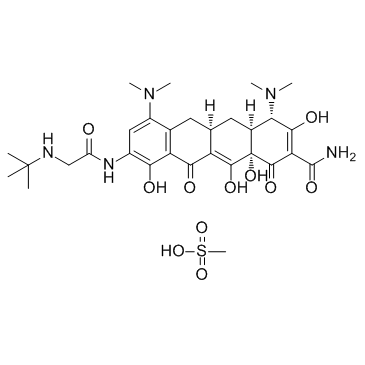1135871-27-0
| Name | Tigecycline mesylate |
|---|---|
| Synonyms |
2-Naphthacenecarboxamide, 4,7-bis(dimethylamino)-9-[[2-[(1,1-dimethylethyl)amino]acetyl]amino]-1,4,4a,5,5a,6,11,12a-octahydro-3,10,12,12a-tetrahydroxy-1,11-dioxo-, (4S,4aS,5aR,12aS)-, methanesulfonate (1:1) (salt)
(4S,4aS,5aR,12aS)-4,7-Bis(dimethylamino)-3,10,12,12a-tetrahydroxy-9-{[N-(2-methyl-2-propanyl)glycyl]amino}-1,11-dioxo-1,4,4a,5,5a,6,11,12a-octahydro-2-tetracenecarboxamide methanesulfonate (1:1) |
| Description | Tigecycline mesylate a first-in-class, broad spectrum antibiotic with activity against antibiotic-resistant organisms.Target: AntibacterialTigecycline mesylate is active against a broad range of gram-negative and gram-positive bacterial species including clinically important multidrug-resistant nosocomial and community-acquired bacterial pathogens. Tigecycline mesylate has been shown to inhibit the translation elongation step by binding to the ribosome 30S subunit and preventing aminoacylated tRNAs to accommodate in the ribosomal A site [1]. Tigecycline mesylate has also been found to be effective for the treatment of community- as well as hospital-acquired and ventilator-associated pneumonia and bacteremia, sepsis with shock and urinary tract infections. Tigecycline mesylate appears to be a valuable treatment option for the management of superbugs, especially where conventional therapy has failed [2].Fifteen patients received tigecycline mesylate for 16 episodes of CPKP infection. The main infections were pneumonia (31%), urinary tract infection (31%), peritonitis (20%), catheter-related bacteraemia (12%), and meningitis (6%). Most infections were complicated with severe sepsis (44%), septic shock (12%), and/or bacteraemia (19%). The daily maintenance dose of tigecycline mesylate was 200 mg in 10 episodes and 100 mg in 6 episodes. The overall 30-day mortality rate was 25%. Univariate analysis showed that mortality was significantly associated (p < 0.01) with mean APACHE II and SOFA scores and the presence of immunosuppression, but not with the tigecycline mesylate dose [3].Clinical indications: Acinetobacter infection; Bacterial infection; Bacterial pneumonia; Bacterial skin infection; Bacteroides fragilis infection; Bacteroides infection; Citrobacter infection; Clostridiaceae infection; Clostridium difficile infection; Clostridium infection; Enterobacter infectionFDA Approved Date: June 17, 2005 Toxicity: nausea; vomiting; diarrhea; local IV-site reaction; infection; fever; headache |
|---|---|
| Related Catalog | |
| References |
[2]. Bhattacharya M, et al. Tigecycline. J Postgrad Med. 2009 Jan-Mar;55(1):65-8. |
| Molecular Formula | C30H43N5O11S |
|---|---|
| Molecular Weight | 681.754 |
| Exact Mass | 681.268005 |
| Storage condition | 2-8℃ |
